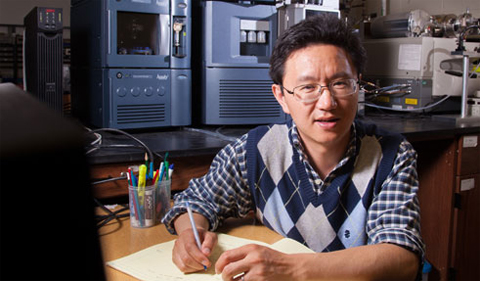
Dr. Hao Chen
By Daniel Kington
From the Voinovich School of Leadership and Public Affairs
Two Ohio University research teams were selected for the third I-Corps@Ohio cohort and are currently in the midst of the seven-week program as they work to validate the market potential of their proposed technologies and learn about launching startup companies.
One of the teams is led by Dr. Hao Chen (PI), with Pengyi Zhao and Cassidy Cleland (ELs), Lee Groeschl and Michele Migliuolo (EMs).
- Chen is Professor of Chemistry & Biochemistry.
- Zhao is a Ph.D. student in chemistry and biochemistry.
- Groeschl is an Executive-in-Residence with TechGROWTH Ohio.
- Migliuolo is an Executive-in-Residence with TechGROWTH Ohio.
- Cleland is an undergraduate student in the Honors Tutorial College and a Voinovich Undergraduate Research Scholar.
Chen’s team is working to commercialize a devise designed to expand the capabilities of a chemical analysis methodology. Chen’s technology will improve the efficiency and accuracy of analysis and could be employed for a variety of functions, such as academic research, biotechnology, and forensic analysis.
Cleland, the only undergraduate working on either team, said she has developed substantially as a researcher through her work with Chen.
“Working on a team to commercialize Dr. Chen’s new device has been incredibly rewarding so far and I hope to gain much more as the program finishes,” Cleland said. “I have learned a great deal about networking, conducting interviews and mass spectrometry throughout this program. I hope to learn more about developing a product for market as the program ends.”
The other team is led by Guy Riefler (PI), with John Timmons (EL), David McCarley (EM).
- Riefler is an associate professor of civil engineering.
- Timmons is a graduate assistant and researcher in civil engineering.
- McCarley is the technical and administrative manager of SE Technologies.
The two OHIO teams of faculty and students join other university teams from across the state and follow in the footsteps of the six OHIO teams that participated in the program over the past two years. Each team receives intense experiential learning in business modeling, commercial opportunities, and product development, as well as $15,000 to aid in their startups. After completing the program, the teams will be eligible for significantly discounted match funding requirements should they be selected for Ohio Third Frontier’s Technology Validation and StartUp Fund program.
“This program is designed to help university researchers capture the commercial rewards of their discoveries, and reinvest those rewards in additional discovery, and we are pleased with the progress made so far,” Ohio Department of Higher Education Chancellor John Carey said.
Lee Groeschl, Executive-in-Residence at TechGROWTH Ohio, a program of the Voinovich School of Leadership and Public Affairs, helped select this year’s teams and now serves as one team’s executive mentor. Groeschl identifies both teams as having considerable promise.
“The principal investigators have both engaged in very high quality, progressive research,” Groeschl said. “They have spent so much time digging into the methods and practice behind their research and have led to new discoveries at Ohio University. Both teams have commercial potential.”
Groeschl went on to say that working alongside such accomplished faculty in an intensive program should be hugely beneficial for the students selected to work on their teams. “Students get first-hand experience in innovative approaches and a customer-centered business model, which necessitates that students consider how to create value for the end user.”
Each team combines one or more principal investigators (PI), entrepreneurial leads (EL) and executive mentors (EM) from the industry.
Riefler’s team is developing a system that remediates waterways polluted by acid mine drainage, and converts an iron byproduct of the purification process into a commercially viable pigment. The technology simultaneously creates a social value in reclaiming surface mining land, as well as creating a commercial value – all at no cost to the state.
Timmons said working with Riefler on the I-Corps project has helped him to think about environmental restoration differently.
“Ultimately I hope to treat as many polluted streams as possible, and a business seems to be the best vehicle to achieve that,” Timmons said. “To scientists and engineers, a business mindset may not be inherent, which is why this program is essential.”
I-Corp@Ohio is sponsored by the Ohio Department of Higher Education (ODHE) and is modeled after a similar program through the National Science Foundation. The ODHE hopes to use I-Corps to encourage innovation and industry collaboration, as well as bring financial rewards to public universities and the state for their research discoveries.
To learn more about I-Corps@Ohio, visit their website.


















Comments